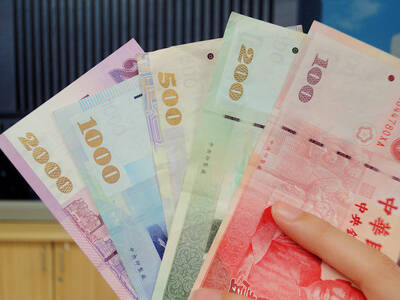The US dollar held in a narrow range against the other main currencies on Friday as traders tried to gauge the impact of a massive financial sector bailout and digested news of bigger-than-expected US job losses.
The euro, which had at one point plunged to a near 12-month low of US$1.3703, later rebounded and was trading at US$1.3781 at 9pm GMT against US$1.3818 late on Thursday. The US currency was little changed at ¥105.27 from ¥105.28 on Thursday.
Trading was volatile as dealers kept a close eye on events in Washington, where the US House of Representatives approved a US$700 billion plan to salvage the shattered financial system and restore confidence to global lenders. The measure was quickly signed by US President George W. Bush.
John Kicklighter at Forex Capital Markets cited a “muted reaction” from traders, suggesting “there may be skepticism over this bill’s effectiveness.”
While markets tried to assess the impact of the plan, trade was impacted by the troubles in the banking sector.
“The euro weakened against the dollar after a surge in demand for dollars,” Christine Li at Moody’s Economy.com said.
“The escalation in the financial turmoil has caused many European financial institutions to seek to repay their dollar loans, causing a shortage,” Li said.
Earlier in the day, the euro was under pressure from comments by European Central Bank (ECB) President Jean-Claude Trichet that were taken to mean a reduction in eurozone interest rates, perhaps as early as next month.
Trichet signaled a shift at the ECB, where it now appears that threats to eurozone growth, rather that inflation, are concentrating minds.
Analysts said the change in priorities pointed to a cut in the benchmark rate, which currently stands at 4.25 percent, far higher than the US Federal Reserve’s 2 percent.
The dollar’s gains were later stalled on a report from the US Labor Department that the US economy lost 159,000 jobs last month as the weight of a housing collapse and credit crunch hit a broad swath of industries.
The report, seen as one of the best indicators of economic momentum, showed a sharp rise in the number of cuts after 73,000 job losses in August.
In late New York trading, the dollar stood at 1.1287 Swiss francs from SF1.1353 on Thursday.
The pound was at US$1.7722 after US$1.7635 on Thursday.
Malaysia’s ringgit and the Thai baht fell this week on concern the deepening credit crisis will push the US economy into a recession and reduce demand for Asian exports and emerging-market assets.
The Philippine peso and the Singapore dollar also declined as a regional stock index slumped 7.6 percent, the worst week in 13 months. Overseas investors pulled almost 26 billion ringgit (US$7.5 billion) from Malaysia’s debt market since April, according to data from the central bank.
The ringgit fell 0.9 percent this week to 3.4670 per US dollar as of 4:15pm on Friday in Kuala Lumpur, its biggest decline since the five days ended Sept. 5, according to data compiled by Bloomberg. The baht declined 0.8 percent this week to 34.21.
The Singapore dollar dropped 1.4 percent in the five days to S$1.4488.
The Philippine peso declined 0.6 percent this week to 47.025, extending its losses this year to 12.2 percent, according to Tullett Prebon Plc.
Elsewhere, the New Taiwan dollar lost 0.4 percent this week to NT$32.18 and Vietnam’s dong was unchanged at 16,600.

People can preregister to receive their NT$10,000 (US$325) cash distributed from the central government on Nov. 5 after President William Lai (賴清德) yesterday signed the Special Budget for Strengthening Economic, Social and National Security Resilience, the Executive Yuan told a news conference last night. The special budget, passed by the Legislative Yuan on Friday last week with a cash handout budget of NT$236 billion, was officially submitted to the Executive Yuan and the Presidential Office yesterday afternoon. People can register through the official Web site at https://10000.gov.tw to have the funds deposited into their bank accounts, withdraw the funds at automated teller

PEACE AND STABILITY: Maintaining the cross-strait ‘status quo’ has long been the government’s position, the Ministry of Foreign Affairs said Taiwan is committed to maintaining the cross-strait “status quo” and seeks no escalation of tensions, the Ministry of Foreign Affairs (MOFA) said yesterday, rebutting a Time magazine opinion piece that described President William Lai (賴清德) as a “reckless leader.” The article, titled “The US Must Beware of Taiwan’s Reckless Leader,” was written by Lyle Goldstein, director of the Asia Program at the Washington-based Defense Priorities think tank. Goldstein wrote that Taiwan is “the world’s most dangerous flashpoint” amid ongoing conflicts in the Middle East and Russia’s invasion of Ukraine. He said that the situation in the Taiwan Strait has become less stable

CONCESSION: A Shin Kong official said that the firm was ‘willing to contribute’ to the nation, as the move would enable Nvidia Crop to build its headquarters in Taiwan Shin Kong Life Insurance Co (新光人壽) yesterday said it would relinquish land-use rights, or known as surface rights, for two plots in Taipei’s Beitou District (北投), paving the way for Nvidia Corp to expand its office footprint in Taiwan. The insurer said it made the decision “in the interest of the nation’s greater good” and would not seek compensation from taxpayers for potential future losses, calling the move a gesture to resolve a months-long impasse among the insurer, the Taipei City Government and the US chip giant. “The decision was made on the condition that the Taipei City Government reimburses the related

FRESH LOOK: A committee would gather expert and public input on the themes and visual motifs that would appear on the notes, the central bank governor said The central bank has launched a comprehensive redesign of New Taiwan dollar banknotes to enhance anti-counterfeiting measures, improve accessibility and align the bills with global sustainability standards, Governor Yang Chin-long (楊金龍) told a meeting of the legislature’s Finance Committee yesterday. The overhaul would affect all five denominations — NT$100, NT$200, NT$500, NT$1,000 and NT$2,000 notes — but not coins, Yang said. It would be the first major update to the banknotes in 24 years, as the current series, introduced in 2001, has remained in circulation amid rapid advances in printing technology and security standards. “Updating the notes is essential to safeguard the integrity